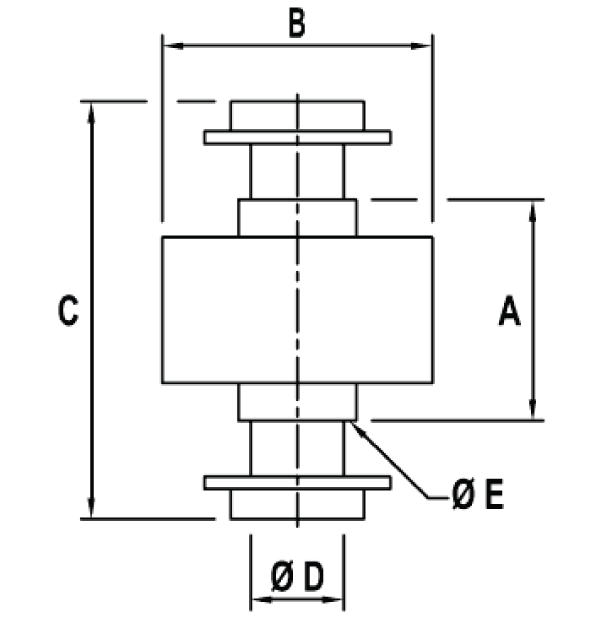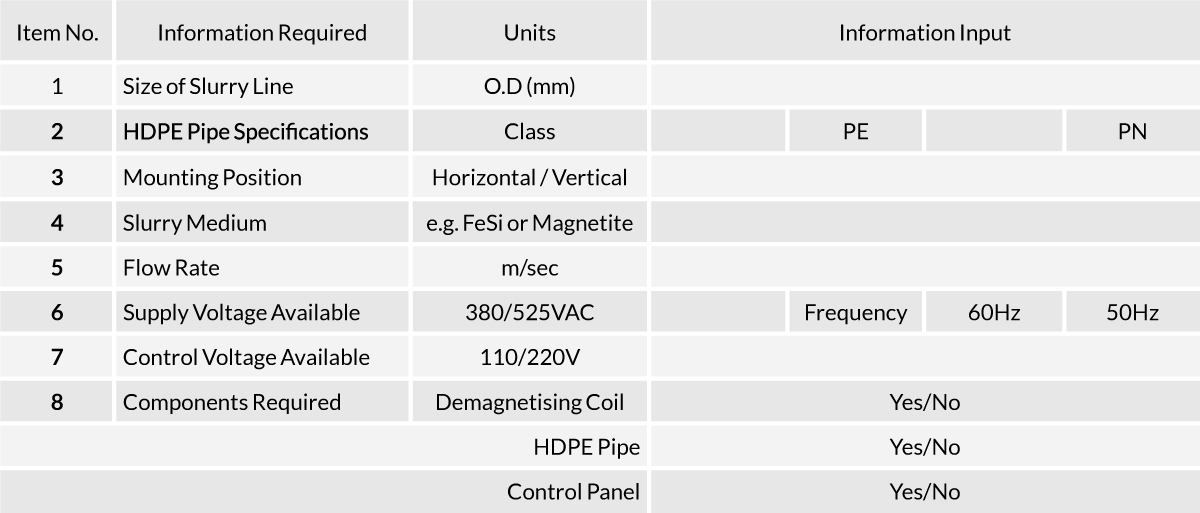DEMAGNETISING COILS
Demagnetising Coils have been developed to demagnetise Magnetite and Ferro-magnetic medium flowing in a slurry through vertical pipelines, as in the case of concentrate exiting from a Wet Drum Magnetic Separator.
Demagnetising Coils are available in internal diameters of 4, 5, 6, 8 & 10 inch. Various other sizes are available on request.

DEMAGNETISING COILS
Demagnetising Coils have been developed to demagnetise Magnetite and Ferro-magnetic medium flowing in a slurry through vertical pipelines, as in the case of concentrate exiting from a Wet Drum Magnetic Separator.
Demagnetising Coils are available in internal diameters of 4, 5, 6, 8 & 10 inch. Various other sizes are available on request.

construction
The coils, made from varnished copper wire which is
wound around a bobbin, are protected from moisture
ingress and physical damage by epoxy resin and laser
cut stainless steel guards.
The bobbin is made from electrical grade non- metallic
material. The coil winding is suitable for operating
temperatures of 80° to 95° C and is protected from
overheating by thermistors wound into the coil.
The thermistors have a maximum cut-off point,
pre-set at 105° C and are terminated in an I.P. 55
terminaI box.
A separate (Optional) HDPE pipe is used to transport
the slurry medium through the centre of the coil.
General
Whilst demagnetising coils are relatively maintenance
free, they should be inspected regularly to ensure they
are free of mechanical damage.
If any debris (magnetic / non-magnetic particles) have
collected between the bobbin and the pipe conveying
the slurry, these must be removed. The magnetic slurry must not be allowed to solidify within the slurry line passing through the demagnetising coil.

INSTALLATION
The demagnetising coil must be mounted so that the pipe
conveying the slurry which is to be demagnetised passes
through the centre of the coil. The pipeline conveying the slurry medium must be of non-metallic material i.e., HDPE, plastic or rubber etc. As the unit is uniform in design, either end can be used as the in let. The demagnetising coil can be suspended using wire ropes slings or by flanging the slurry line directly to the (Optional) HDPE pipe.
All Connetions are made via a waterproof terminal box
mounted on the underside of the coil. The thermistors
may be connected to a thermistor relay. Failure to
connect in conjunction with a thermistor relay will
eliinate any form of overheating protection and may
result in possible damage to the coil. The demagnetising
coil should be mounted / suspended in such a way that it
is protected from falling objects or splashing water.
INSTALLATION
The demagnetising coil must be mounted so that the pipe
conveying the slurry which is to be demagnetised passes
through the centre of the coil. The pipeline conveying the slurry medium must be of non-metallic material i.e., HDPE, plastic or rubber etc. As the unit is uniform in design, either end can be used as the in let. The demagnetising coil can be suspended using wire ropes slings or by flanging the slurry line directly to the (Optional) HDPE pipe.
All Connetions are made via a waterproof terminal box
mounted on the underside of the coil. The thermistors
may be connected to a thermistor relay. Failure to
connect in conjunction with a thermistor relay will
eliinate any form of overheating protection and may
result in possible damage to the coil. The demagnetising
coil should be mounted / suspended in such a way that it
is protected from falling objects or splashing water.
PRODUCT
RANGE







